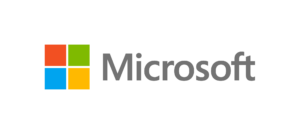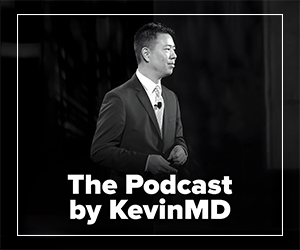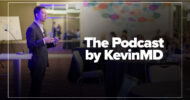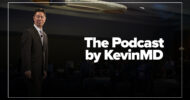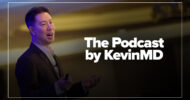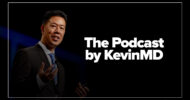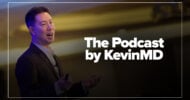Subscribe to The Podcast by KevinMD. Watch on YouTube. Catch up on old episodes!
Child psychiatrist and entrepreneur Marissa Caudill discusses her article, “How a customer relationship management tool (CRM) can help physicians regain control and beat burnout.” She argues that a significant driver of physician burnout is the lack of control within systems that prioritize metrics and administrative tasks over meaningful patient connections, leaving doctors feeling overwhelmed and disconnected. Marissa proposes that physicians can regain control and find more joy by implementing their own systems, specifically highlighting the power of customer relationship management (CRM) tools. She explains how a HIPAA-compliant CRM allows physicians to automate communication (like newsletters, check-ins, scheduling), enhance patient relationships, manage educational content, and ethically market their services—reframing marketing as connection—all while freeing up time. Marissa shares her transformative experience using a CRM with AI features in her parent coaching practice, enabling greater impact and easier communication. Ultimately, she contends that such tools help physicians focus on patient care, build financially stable practices potentially beyond insurance constraints, and reconnect with their original purpose.
Our presenting sponsor is Microsoft Dragon Copilot.
Microsoft Dragon Copilot, your AI assistant for clinical workflow, is transforming how clinicians work. Now you can streamline and customize documentation, surface information right at the point of care, and automate tasks with just a click.
Part of Microsoft Cloud for Healthcare, Dragon Copilot offers an extensible AI workspace and a single, integrated platform to help unlock new levels of efficiency. Plus, it’s backed by a proven track record and decades of clinical expertise—and it’s built on a foundation of trust.
It’s time to ease your administrative burdens and stay focused on what matters most with Dragon Copilot, your AI assistant for clinical workflow.
VISIT SPONSOR → https://aka.ms/kevinmd
SUBSCRIBE TO THE PODCAST → https://www.kevinmd.com/podcast
RECOMMENDED BY KEVINMD → https://www.kevinmd.com/recommended
Transcript
Kevin Pho: Hi, and welcome to the show. Subscribe at KevinMD.com/podcast. Today we welcome back Marissa Caudill. She is a child psychiatrist and an entrepreneur. Today’s KevinMD article is “How a customer relationship management tool or CRM can help physicians regain control and beat burnout.” Marissa, welcome back to the show.
Marissa Caudill: Thanks, Kevin. Thanks for having me back.
Kevin Pho: Alright. What’s your latest article about?
Marissa Caudill: Well, I’m sure you are familiar with what a CRM tool is as KevinMD because you’re obviously doing amazing outreach stuff. I really want to thank you for the forum that you provide for us to be able to speak to each other and the world. But many physicians in practice, and I myself was one of them, have no idea what the acronym CRM even means. I think 90 plus percent of physicians, if I asked them, wouldn’t know. So I wrote the article to help people understand what it is so they can start to brainstorm how it might help them.
Business people have known about CRM for years and years. Essentially, these software tools are things you’ve probably heard of: things like Salesforce, GoHighLevel, Mailchimp, ClickFunnels, ConvertKit. Many of us may have heard of these things or not, but essentially it’s like email on steroids. It’s a way to keep track of all of the people you might want to keep track of.
My story is that I was a busy child psychiatrist working within the Southern California Kaiser Permanente system, and I was there for over four years. I had over 1,800 patients when I left, and as many of the people listening probably can relate, I was scheduled by other people from the moment I entered the office until I left and I would see 13, 14 patients a day. I would think, gosh, there’s got to be a more efficient way for me to do this job. But I was so busy that I didn’t have the bandwidth to actually sharpen the ax. You know that Abraham Lincoln saying: if I had six hours to chop down a tree, I’d spend the first four sharpening my ax. I feel like as busy clinicians, we are never given that time by administration if we don’t have control over our schedules to sharpen our ax.
For me, what I’ve learned since leaving my job at Kaiser is that when you take the time using a CRM to sharpen your ax, your impact clinically and professionally can be so much greater. Because when we’re working clinically one-on-one with our patients—I myself, as a child psychiatrist, was joking back when I was working full time—like, you know, I must give this informed consent spiel about SSRI use in kids about three to five times every day. I really should make my own YouTube channel and have this be a video, but I never had time to record a video. And even if I had time, usually at the end of my workday, I just wanted to unplug. I didn’t want to be making a YouTube channel.
But now that I have separated from a busy clinical job, I can actually think better about what is the best way to get information out to people. How can I help parents support their kids’ mental health? I mean, I’m talking just about my point of view as a child psychiatrist, right? But I think regardless of what field of medicine you’re in, if you give yourself some downtime to think about how would I really want to share my amazing information, experience, and education with my patients in a way that’s useful? You’re limited when you’re only one-on-one with your patients in the clinic, right? Because you have some days when you’re having a great day and you’re on a roll and you’re really sharing information that you feel like people can use, and you have other days when inevitably you’re going to be overwhelmed or kind of feeling frustrated or running behind, and you’re going to be more rushed and you may not go through things in a systematic way and as useful a way as you do on your best days.
So what a CRM can do is allow you to provide education to your patients, provide resources to them, because essentially you can have a list you can contact to say, “Hey, I’m going to get on Zoom and host this webinar on such and such topic if anyone wants to join,” or “Would you like to join my newsletter?” Maybe you send out a weekly or a monthly update with information in your field. So that’s what I use CRM for. And do you want to add anything to that? I mean, what do you use it for and how do you use CRM? Because I imagine you must have some kind of CRM behind KevinMD, right?
Kevin Pho: I do. So of course the biggest thing would be the mailing list. And I think the biggest thing is that people consume information in such different ways, and there is a much bigger proportion than a lot of people think that still get their information from email. So I summarize weeks’ worth of articles on my email newsletter, and people who subscribe to the newsletter tend to be your most engaged audience, right? So that’s the way I primarily use KevinMD, the newsletter, to kind of keep in contact with these most engaged listeners.
Marissa Caudill: And even though that was probably a lot of work for you to set up—it was a lot of work for me to set mine up too—did you find, as you started to feel the benefit from that engagement with the people who really are the folks who resonate most with what you’re doing, that you felt more exhausted because you were doing more work? Or did you find that you felt more energized?
Kevin Pho: So I think with all of these things, it’s always going to be upfront, right? You have to put in the capital of resources and once you get that done, it’s not that it’s automated, but the workload and the amount of effort and time that you put in is substantially less. So, I think the learning curve, because it’s not something that’s often taught, takes a lot of energy and resources. But then once you learn that and set up the workflows—and workflows is one of the things I’m pretty good at—once you set those up, then it becomes more routine.
Marissa Caudill: I agree. It becomes more routine. And then I’m sure you feel this too: you start to reap the rewards in an increasing way, right? Like once you set up those automations and routines, let’s say you’re a physician who doesn’t now have a newsletter, but you have a huge patient base. Maybe you’re a nephrologist or a cardiologist or a weight loss specialist; you may be kind of burnt out seeing thousands of patients in a system job, like a Kaiser job or a university hospital job or a health care system job. But if you can start engaging with the people who really know, like, and trust you the most in a way that they’re going to be reaching out to you regularly and being like, “Thank you so much. That article was awesome,” or giving you positive feedback, it really helps you to feel re-energized—at least it did for me—with the reason that we went into medicine in the first place, which otherwise in the daily grind, we can kind of lose sight of.
So I just feel like many health care systems, many EMRs, they don’t have this piece that the business side CRM can provide to us. And that’s why I started the company that I started this year called Super Doc Tech, which is based on GoHighLevel’s platform. And I love it because it really allows me to do so many things in one place with one log on. So I’m able to have a top of the funnel for my parent coaching business, The Parent Doctor, where I can advertise on social media and say like, “Hey, would you like to join my monthly book club? It’s free; comment ‘book’ below.” And I have an automation in place with my CRM where on any social media post, if someone comments “book,” they’re going to get a link to sign up. I get their email, now they’re on my list. Now I can send out my weekly newsletters to them, let them know about upcoming events and workshops that I’m doing, invite them to learn more with me.
So it’s just a way that I now get more engagement from a wider base of people who are interested in me and what I have to offer. And I think as physicians, a lot of times it can feel uncomfortable to kind of put yourself out there in that way. If you are just working in a clinic and you don’t have a YouTube channel or an Instagram page, that step is in and of itself a hurdle, but there are lots of people out there who can support you. And it is one of those things that the more you do it, the easier it gets. I mean, I was actually thinking this morning, coming on this podcast: the first one I did with you, I was a little nervous; this one I’m much calmer. And I was remembering the very first podcast I ever recorded, and I want to go back and listen to it because I know I was a nervous wreck and it sounded horrible. But now I’ve done it—it’s a podcast—and it gets easier as you do it, right?
Again, it’s all about just getting started. Like if you have the knowledge inside you—and I think every physician has to acknowledge that we’re great. Like we’re amazing people. We have good hearts; we have good information that people need. And ultimately, if you’re not willing to go outside your comfort zone and learn these tools to be able to reach more people, then you’re not doing the service to the world that you could do. So I think we kind of have to ask ourselves: like, am I burnt out because I’m doing too much, or am I burnt out because I’m not doing enough that I know I could do to reach more people? So I think the cure to burnout is really feeling more in control and having more agency.
And so I think investing the time, money, and energy that it takes to learn how to use a CRM tool—whether that’s the one I offer or the one you’re using, or anyone, there are many out there—is really worthwhile for physicians to do. And I think even for employed physicians, if you talk to your bosses, they’re going to support you in that because ultimately you’re adding to their value of their brand. You’re adding additional services for patient care. And if you’re kind of one foot in the door, one foot out of the door, you can do it initially saying that you’re helping the group, but ultimately then you have a list of people. If you do decide you want to go out on your own in private practice or something like that, you can connect with those people. You have a following.
So it’s all about just kind of being willing to step out into the arena, as Brené Brown says that Theodore Roosevelt quote, right? Like of just being able to stand out on your own, brand yourself as the doctor that you are, and embrace that to attract the people who are out there looking for you. Because the problem is, I don’t care who you are, I don’t care whether you’re good on camera, you know, you have an accent, whatever it is. Like you have something to offer and there are people who will want to listen to you in the world, but if you don’t put yourself out there, no one can find you. And I think CRM is a tool for you to put yourself out there and connect with people in a really useful way.
Kevin Pho: So there is an obvious use case scenario for CRMs for physicians who have their own platform like you do, and of course, what I do with KevinMD. So you mentioned how it could also be useful for what you call systems physicians, right? Physicians who are employed, work for large health care systems. Give us some specific use case scenarios. I know you talked about it earlier, but go into more detail about people who are employed. For instance, they’re listening to you on podcasts and they’re still just on the fence. You know, “I don’t have a platform. I’m not like KevinMD or I’m not like you. I don’t have a coaching business on the side where I need to get clients.” But tell me the use case scenario for physicians who just see 20 patients a day, they want to just go home and maybe disconnect from medicine. You know, that’s the majority of the physicians that are practicing today. So what’s in it for them?
Marissa Caudill: Well, I think what’s in it for them—and I think my husband is actually sort of the poster child for this—so he works in a W2 position. He is a Medicare-accepting geriatric psychiatrist. He loves what he does. It’s aligned with his heart and he’s great at it. He’s a great clinician, but he also wants to be able to offer people additional information and education. And he has some patients who want to know, really, how can I protect my brain? What about nutrition? You know, they ask him all these questions in their 15- or 30-minute visit that he just doesn’t have time to answer. So he’s using this platform to give a newsletter to his patients and to do monthly interviews with like a nutritionist or an exercise specialist and letting people know, you know, what are the ways that they really can implement healthful habits and changes to make their brains healthier as they age.
So that’s one example. CRM can help you with other things too. So if you do have a private practice and you’re spending a lot of money or thinking about spending a lot of money on SEO or marketing, you should know that when it comes to finding you, most people use Google. That’s the most common search engine. And the cheapest way and best way that you can optimize your SEO is actually by having a lot of positive Google Business Profile reviews. And a CRM can help you automate that from your existing patient base and make it such that for each patient you see, they get an email saying like, “Hey, I hope you had a great experience. Could you please rate us?” And that’s a way to automatically boost your visibility, your new patients coming to find you, just your SEO. So there are a lot of use cases.
And then I work with many physicians too who have their day job, but then they have some other idea. Maybe they want to do a coaching thing on the side. You know, maybe you’re an endocrinologist, but you want to do some like menopause hormone telehealth. Or maybe you are a pediatric dermatologist, but you want to do some telehealth or coaching about parents to help their kids with eczema. These are all ways that we now can expand and with technology, with Zoom, with online courses, there are so many ways that we can make ourselves available more broadly than we can in a clinic setting where people have to make an appointment and see us one-to-one, right?
So a CRM is another way that you can think about all the ways you can reach out to potential customers, and if you get to the point that you want to run ads, you can even be running ads for that. But even just word of mouth, you probably know a lot of physicians if you’ve been in practice in your community, other specialists who refer to you. In my case, as a psychiatrist, I know many other psychiatrists, therapists, educators, schools, and the CRM also helps me keep track of those professional networks in a way that I wasn’t doing before. So I have a separate list with tags of my professional network, and if I’m doing something new that I want my network to know about, I no longer have to sit down and think, “OK, who are the friends I know who I could email?” I can just search for that tag of my professional network, send out an email. It looks like a personalized email because it says, “Hi Kevin,” you know, it pulls in their name. And it gives the information and then it can share like a link or a website or a funnel for them to share with their patients. I can share a printable PDF that they can post in their office to send new referrals my way. There are just so many ways you can use it, and as you get into it and start to use it, your creative juices start flowing and you see all of the value it can bring to you.
Kevin Pho: We’re talking to Marissa Caudill. She’s a child psychiatrist and entrepreneur. Today’s KevinMD article is “How a customer relationship management tool or CRM can help physicians regain control and beat burnout.” Marissa, let’s end with some take-home messages you want to leave with the KevinMD audience.
Marissa Caudill: I think having been there myself, if you are working in an employed job where you’re feeling sometimes frustrated, feeling a little bit disconnected from the passion and fire in your heart that brought you to medicine in the first place, take a deep breath and think about what would it really look like in an ideal world if you were providing people with the information that you have, knowing that you have valuable information in your brain. How could you do that in a way that would feel better to you, reach more people, and be more efficient? And then ask yourself, OK, who can help me? Who’s a person doing this that I can reach out to and take a step in that direction? Don’t be afraid because you can do it.
Like the people who are doing this—you probably know some people in your area who are on Instagram or on YouTube, right? And you probably think, “Oh, I could never do that.” But the truth is they have nothing that you don’t have. So ask yourself, what would be something that would feel right to you, feel wholesome to you, feel aligned with who you are? You don’t have to do something that doesn’t feel right to you. You don’t have to dance on TikTok, but think about what is something that I could do differently? How could I sharpen my ax in a way that would help me feel more in control? Because having more control is the cure for feeling burnt out, and it does take a little bit of effort and thinking about things in a different way, but the answers are all there. So if it’s of interest to you, feel free to reach out to me, reach out to other people, and start exploring what you could do.
Kevin Pho: Marissa, thank you so much for sharing your perspective and insight, and thanks again for coming back on the show.
Marissa Caudill: Thank you, Kevin. Take care.


